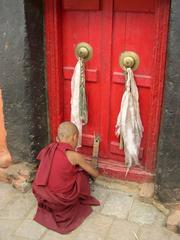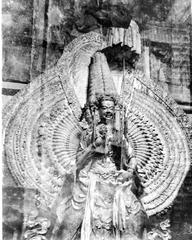Palace of Stok: Visiting Hours, Tickets, and Leh Historical Sites Guide
Date: 04/07/2025
Introduction
Set against the dramatic backdrop of the Stok Kangri range, the Palace of Stok stands as a living testament to Ladakh’s royal heritage and architectural ingenuity. Located just 15 kilometers from Leh in the tranquil village of Stok, this 200-year-old palace is both a residence for the Namgyal dynasty and a vibrant museum, offering visitors a rare glimpse into Ladakh’s cultural and spiritual traditions. Unlike many relics of Himalayan royalty, Stok Palace remains inhabited and continues to play a central role in Ladakhi life, making it an essential stop for travelers and history enthusiasts alike (Wikipedia entry on Leh Palace, WanderOn guide to Stok Palace Heritage, Hill Post article on Stok Palace architecture).
This detailed guide provides practical information on visiting hours, ticketing, accessibility, and travel tips. It also explores the palace’s history, architectural highlights, cultural significance, and its role as a living heritage site in Ladakh.
Overview: What to Expect at Stok Palace
- Location: Stok Village, 15 km from Leh, Ladakh
- Visiting Hours: 8:00/9:00 AM to 5:00 PM daily (seasonal variations may apply)
- Ticket Prices: ₹50–₹100 (Indian nationals), ₹200–₹400 (foreign nationals); separate museum charges may apply
- Accessibility: Historic structure with uneven terrain; not wheelchair accessible
- Best Visiting Season: May to September (pleasant weather, festivals, open roads)
- Key Features: Royal apartments, private monastery, museum, heritage hotel, gardens
Historical Background and Construction
Stok Palace was constructed in 1820 by King Tsepal Namgyal of the Namgyal dynasty after political upheaval forced the royal family to abandon Leh Palace in the mid-19th century (Wikipedia - Leh Palace). The Namgyal dynasty’s shift from Leh to Stok marked a new chapter in Ladakh’s history, ensuring the continuity of Ladakhi royal traditions. Today, the palace remains both a royal residence and a museum, uniquely blending living heritage with public engagement (Travelling Camera - Leh Palace).
Architectural Features and Layout
Stok Palace exemplifies the fusion of Ladakhi and Tibetan architectural styles, designed to withstand the region’s harsh climate. Built primarily from local stone, mud bricks, and timber, its thick walls provide insulation against cold, while flat roofs and small windows minimize heat loss. The palace is organized into:
- Royal Apartments: Lavishly decorated with antique furnishings, thangkas, and historical heirlooms, these rooms offer insights into the Namgyal rulers’ lifestyle.
- Private Monastery (Gompa): Houses vibrant Buddhist murals and sacred relics, emphasizing the spiritual life of the palace (WanderOn - Stok Palace Heritage).
- Museum: Showcases royal regalia, ceremonial attire, ancient manuscripts, jewelry, the Queen’s crown, and centuries-old thangkas (Wikipedia - Leh Palace).
- Gardens and Orchards (Chulli Bagh): Lush surroundings that offer fresh produce and tranquil spaces for visitors.
The organic layout, interconnected courtyards, and strategic elevation provide security, privacy, and panoramic views of the Indus Valley (Voice of Ladakh, Hill Post).
Visitor Information: Hours, Tickets, and Facilities
Visiting Hours
- Open daily from 8:00/9:00 AM to 5:00 PM
- Hours may vary seasonally or during festivals; always confirm locally or online before your visit (Ekashmir Tourism)
Ticket Prices
- Indian citizens: ₹50–₹100
- Foreign nationals: ₹200–₹400
- Children and senior citizens may receive discounts; confirm at the entrance or via official sites (Ladakh Travel Mart)
Accessibility
- Historic architecture means uneven floors and narrow stairways; not suitable for wheelchairs
- Comfortable walking shoes recommended
- Limited assistance available for those with mobility challenges
Facilities
- Restrooms available within the palace complex and at the heritage hotel
- Heritage hotel serves traditional Ladakhi and Indian cuisine; nearby cafés and eateries in Stok village and Leh offer local delicacies
Photography
- Allowed in most outdoor areas and courtyards
- Flash and tripods are generally prohibited in the museum and temple interiors to protect artifacts
Living Heritage: Culture, Rituals, and Festivals
Stok Palace is more than a museum—it’s a living heritage site. The Namgyal family, led by His Highness Jigmed Wangchuk Namgyal, continues to reside here, preserving royal customs and hosting important festivals such as the Stok Guru Tsechu. This two-day event features Buddhist cham mask dances and sacred rituals, offering an authentic cultural experience (Charzan Holidays - Leh Palace).
The palace’s monastery is a spiritual heart, with daily prayers, ancient thangkas, and amulet-making workshops. Annual festivals and religious ceremonies allow visitors to witness Ladakh’s vibrant traditions firsthand.
Preservation and Restoration
Extensive restoration efforts have preserved Stok Palace’s authenticity, employing traditional Ladakhi construction materials and methods. Modern amenities, such as running water and functional guest suites, have been discreetly integrated for visitor comfort (Architectural Digest India). The palace museum has been enhanced with interpretive displays and improved artifact presentation (WanderOn - Stok Palace Heritage).
Art, Decoration, and Symbolism
Stok Palace is renowned for its:
- Intricate Woodcarvings: Doors, windows, and pillars feature ornate motifs reflecting Tibetan and Ladakhi artistic influences (Voice of Ladakh).
- Murals and Frescoes: Vivid depictions of Buddhist mythology, Ladakhi history, and natural motifs, painted with natural pigments (Hill Post).
- Religious Spaces: The Lhakchung (private chapel) and the palace temple are adorned with sacred relics, thangkas, and ritual objects, emphasizing the integration of spiritual life into the royal residence.
Guided Tours, Accommodation, and Unique Experiences
- Guided Tours: Enhance your understanding of Stok Palace’s rich history, architecture, and cultural significance. Guides are available at the entrance or can be arranged through the heritage hotel (Stok Palace Heritage).
- Heritage Hotel: Stay overnight in elegantly restored suites, blending traditional Ladakhi decor with modern amenities. Advance booking is essential, especially during peak season (Ladakh Travel Now).
- Special Events: Attend the Stok Guru Tsechu or participate in local craft workshops for a deeper cultural immersion.
Travel Tips and Nearby Attractions
- Acclimatization: Stok Palace is at 3,500 meters elevation; spend 1–2 days in Leh before your visit to adjust.
- Protection: Carry water, sunscreen, sunglasses, and dress in layers for temperature changes.
- Connectivity: Mobile and internet coverage may be limited at the palace—download maps and offline info in advance (Third Eye Traveller).
- Nearby Sites: Stok Monastery, Thiksey Monastery, Shey Palace, and Leh Palace are all within easy reach and offer further insights into Ladakh’s heritage (TravelSetu).
Sustainable Tourism and Visitor Etiquette
- Respect restricted/private areas and the privacy of residents
- Dispose of waste responsibly and minimize environmental impact
- Support local artisans by purchasing handicrafts from authorized shops
Frequently Asked Questions (FAQs)
Q: What are the Stok Palace visiting hours?
A: Open daily from 8:00 or 9:00 AM to 5:00 PM; verify for seasonal changes.
Q: How much do tickets cost?
A: ₹50–₹100 for Indian citizens; ₹200–₹400 for foreigners; check for latest rates.
Q: Is Stok Palace wheelchair accessible?
A: No, due to historic architecture and terrain.
Q: Are guided tours available?
A: Yes, at the entrance or via the heritage hotel.
Q: Can I stay overnight at Stok Palace?
A: Yes, heritage hotel suites are available; book in advance.
Q: What nearby sites should I visit?
A: Stok Monastery, Thiksey Monastery, Shey Palace, and Leh Palace.
Emergency Contacts
- Local Police: 100
- Medical Assistance: SNM Hospital, Leh (+91 1982 252 010)
- Tourist Office: Leh Tourism (+91 1982 252 297)
Conclusion
Stok Palace is a living symbol of Ladakh’s royal legacy, architectural brilliance, and spiritual depth. Whether you’re exploring its museum, witnessing vibrant festivals, or experiencing royal hospitality in the heritage hotel, the palace offers a rich, immersive journey into Ladakh’s past and present. Plan your visit during the best season, respect the site’s traditions, and consider a guided tour or overnight stay for the most rewarding experience.
For more information and travel updates, consult official sources and download the Audiala app for real-time alerts, guided tours, and exclusive offers on Ladakh’s historical sites.
Sources
- Wikipedia - Leh Palace
- WanderOn - Stok Palace Heritage
- Hill Post - A Himalayan Jewel: The Architectural Wonders of Stok Palace Ladakh
- Ladakh Travel Mart - Stok Palace
- Stok Palace Heritage - Official Website
- Voice of Ladakh - A Himalayan Jewel: The Architectural Wonders of Stok Palace Ladakh
- Ekashmir Tourism - Stok Palace
- Third Eye Traveller - Leh Ladakh
- TravelSetu - Leh Palace
- Architectural Digest India - Stok Palace
- Charzan Holidays - Leh Palace
- Ladakh Travel Now - Stok Palace
- Travelling Camera - Leh Palace

